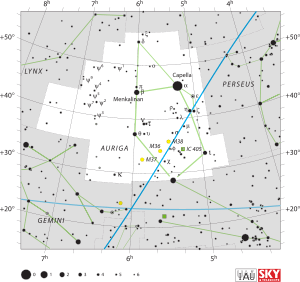Rho Aurigae
 | |
| Observation data Epoch J2000 Equinox J2000 | |
|---|---|
| Constellation | Auriga |
| Right ascension | 05h 21m 48.41650s[1] |
| Declination | +41° 48′ 16.4615″[1] |
| Apparent magnitude (V) | +5.22[2] |
| Characteristics | |
| Spectral type | B5 V[3] |
| U−B color index | –0.57[2] |
| B−V color index | –0.14[2] |
| Astrometry | |
| Radial velocity (Rv) | +13.1[4] km/s |
| Proper motion (μ) | RA: +14.42[1] mas/yr Dec.: –37.32[1] mas/yr |
| Parallax (π) | 6.16 ± 0.36[1] mas |
| Distance | 530 ± 30 ly (162 ± 9 pc) |
| Orbit[5] | |
| Period (P) | 34.49321 ± 0.00057 d |
| Eccentricity (e) | 0.104 ± 0.019 |
| Periastron epoch (T) | 47962.5 ± 2.0 JD |
| Argument of periastron (ω) (secondary) | 3.4 ± 12.0° |
| Semi-amplitude (K1) (primary) | 39.8 ± 0.8 km/s |
| Details | |
| ρ Aur A | |
| Mass | 5–7[5] M☉ |
| Radius | 3.2–3.4[6] R☉ |
| Rotational velocity (v sin i) | 55[7] km/s |
| ρ Aur B | |
| Mass | 2–4[5] M☉ |
| Other designations | |
| Database references | |
| SIMBAD | data |
Rho Aurigae (ρ Aur, ρ Aurigae) is the Bayer designation for a binary star system in the northern constellation of Auriga. It is faintly visible to the naked eye with an apparent visual magnitude of +5.22.[2] Judging by parallax measurements, this system is approximately 530 light-years (160 parsecs) distant from the Earth, give or take a 30 light-year margin of error.[1]
System
ρ Aurigae is a single-lined spectroscopic binary system; the presence of a companion object is revealed by shifts in the stellar spectrum. The pair orbit each other with a period of 34.49 days and an orbital eccentricity of 0.10.[5]
The primary component of this system is a B-type main sequence star defined as a standard star for the stellar classification of B5 V.[3] The deduced mass of the secondary and the lack of evidence for it in the spectrum suggest it may be a B- or A-type star somewhat less luminous than the primary.[5]
Name
In Chinese, 咸池 (Xián Chí), meaning Pool of Harmony, refers to an asterism consisting of ρ Aurigae, λ Aurigae and HD 36041.[9] Consequently, ρ Aurigae itself is known as 咸池一 (Xián Chí yī, English: the First Star of Pool of Harmony.)[10]
References
- 1 2 3 4 5 6 van Leeuwen, Floor (November 2007), "Validation of the new Hipparcos reduction", Astronomy and Astrophysics, 474 (2): 653–664, arXiv:0708.1752v1, Bibcode:2007A&A...474..653V, doi:10.1051/0004-6361:20078357. VizieR catalogue entry I/311.
- 1 2 3 4 Crawford, D. L.; Barnes, J. V.; Golson, J. C. (1971), "Four-color, H-beta, and UBV photometry for bright B-type stars in the northern hemisphere", The Astronomical Journal, 76: 1058, Bibcode:1971AJ.....76.1058C, doi:10.1086/111220.
- 1 2 Morgan, W. W.; Keenan, P. C. (1973), "Spectral Classification", Annual Review of Astronomy and Astrophysics, 11: 29, Bibcode:1973ARA&A..11...29M, doi:10.1146/annurev.aa.11.090173.000333.
- ↑ Evans, D. S. (June 20–24, 1966), "The Revision of the General Catalogue of Radial Velocities", in Batten, Alan Henry; Heard, John Frederick, Determination of Radial Velocities and their Applications, Proceedings from IAU Symposium no. 30, University of Toronto: International Astronomical Union, Bibcode:1967IAUS...30...57E.
- 1 2 3 4 5 Horn, J.; et al. (May 1994), "The orbit of the spectroscopic binary ρ Aurigae", Astronomy and Astrophysics Supplement, 105: 119–124, Bibcode:1994A&AS..105..119H.
- ↑ Pasinetti Fracassini, L. E.; et al. (February 2001), "Catalogue of Apparent Diameters and Absolute Radii of Stars (CADARS) - Third edition - Comments and statistics", Astronomy and Astrophysics, 367: 521–524, arXiv:astro-ph/0012289, Bibcode:2001A&A...367..521P, doi:10.1051/0004-6361:20000451.
- ↑ Abt, Helmut A.; Levato, Hugo; Grosso, Monica (July 2002), "Rotational Velocities of B Stars", The Astrophysical Journal, 573 (1): 359–365, Bibcode:2002ApJ...573..359A, doi:10.1086/340590.
- ↑ "rho Aur". SIMBAD. Centre de données astronomiques de Strasbourg. Retrieved 2012-08-20.
- ↑ 陳久金 (2005). 中國星座神話 (in Chinese). 五南圖書出版股份有限公司. ISBN 978-986-7332-25-7.
- ↑ "天文教育資訊網" [AEEA (Activities of Exhibition and Education in Astronomy)] (in Chinese). 2006-07-13. Retrieved 2018-10-06.
Further reading
- Allen, R. H. (1963), Star Names: Their Lore and Meaning (Reprint ed.), New York, NY: Dover Publications Inc, p. 91, ISBN 0-486-21079-0, retrieved December 12, 2010.
- Rhoads, Jack W. (November 15, 1971), Technical Memorandum 33-507-A Reduced Star Catalog Containing 537 Named Stars (PDF), Jet Propulsion Laboratory, California Institute of Technology, retrieved August 21, 2012.
External links
- HR 1749 in Bright Star Catalogue
- ρ Aurigae image